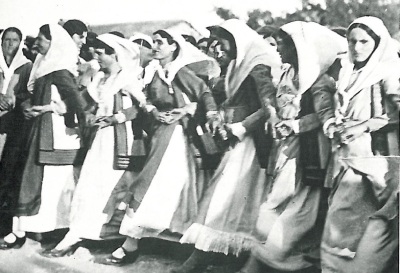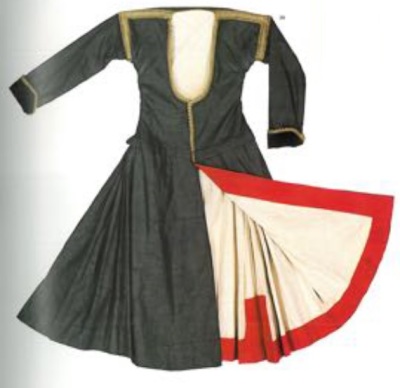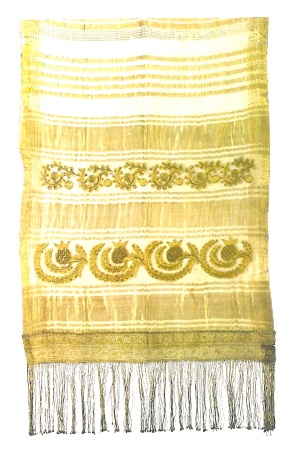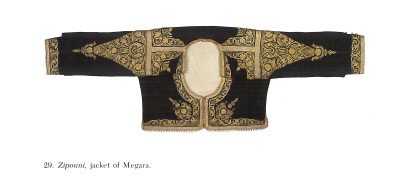 In a previous post on FAR I explored Greek Easter customs which interweave Christian and pre-Christian beliefs. Today I would like to take a closer look at one of these customs, the women’s ritual dance known as Tráta, ceremonially performed on ‘Bright Tuesday,’ the Tuesday after Easter. Versions of Tráta survive in the towns of Mégara and Elefsina just west of Athens, on the island of Salamína directly across from them, and in the surrounding area as far as Thebes.
In a previous post on FAR I explored Greek Easter customs which interweave Christian and pre-Christian beliefs. Today I would like to take a closer look at one of these customs, the women’s ritual dance known as Tráta, ceremonially performed on ‘Bright Tuesday,’ the Tuesday after Easter. Versions of Tráta survive in the towns of Mégara and Elefsina just west of Athens, on the island of Salamína directly across from them, and in the surrounding area as far as Thebes.
Elefsina, of course, is Eleusis, where for over 2,000 years the Eleusinian Mysteries enacted the story of Demeter and her daughter Persephone’s descent to the Underworld. Choral dance was a central part of the ceremonies at Eleusis – as at other sacred sites including Delphi, Knossos, Athens, and Vravrona – and the ‘Well of the Beautiful Dances’ can still be seen at the archaeological site. It is a a visible reminder of the circle dancing which was a part of the initiatory experience, bringing cosmic order – symbolised by the circle – into the human world. This is still one of the functions of the Tráta as performed today.



Initiation into the Eleusinian Mysteries involved the understanding that an ear of grain first must die in order to give new life (whether planted as seed, baked into bread, or made into beer). The phenomenon of death leading to life through the medium of a sacred marriage was celebrated in other archaic springtime festivals, such as those of Aphrodite / Adonis, Cybele / Attys, and Isis / Osiris), from which the Resurrection story of Christian Easter is directly descended. I believe something of these ancient customs survive in the women’s Tráta dance, whose every detail hints at the story of Persephone’s descent and return.

In Megara, the annual ritual of the Tráta is one of the most significant events in the village. Women of all ages gather at the upper square, near the tiny church of ‘Saint John the Dancer’ with its miraculous spring believed to grant fertility. The women’s costumes used to feature strong black, white and red elements, the colours of the Triple Goddess and the three central figures of the Eleusinian drama (Hecate, Demeter and Persephone).

Now they are rich in silk, satins, and gold embroidery, with deep red aprons embroidered with flowing floral and vegetation motifs. The long, pale silk veils – symbol of initiation and the threshold between the worlds – are embroidered with fertility symbols including wheat, sign of Demeter, and pomegranates, traditional food of the dead and symbol of prosperity and abundance chiefly associated with Persephone.


The zipoúni or velvet jacket is richly embroidered in gold, and the sleeves feature the pre-Christian motif of the sun-headed Goddess; unusually, she is depicted head-down instead of right-side-up, as if indicating the direction of descent to the underworld. The overall effect closely resembles the women on the frescoes in the 4th C. BCE Tomb of the Dancing Women in Apuglia, Italy.

The kinetic motif of ascent and descent central to the myth of Persephone is dramatically emphasised by the pronounced zigzag of the dance pattern, visually mirrored in the basketweave handhold, and expressed again in the way the dance spirals completely in and out as you can see in the video. The Tráta is one of the few traditional Greek dances which do this, in a labyrinthine movement of deepening and emerging which magnifies the inwards-outwards, ascending-descending theme.
In a reversal of normal procedure, young unmarried girls lead the older married women in the dance line: the daughter is the agent in this danced symbolic journey. Among the mature women at the back of the line are the strongest singers, those able to sing loudly enough for the dancers at the front to hear, even when the circle is large and the dance line snakes and spirals around.
This spiralling movement is stunning to watch. In Mégara in the late 1940s, Kevin Andrews described it thus: ‘A long line of a hundred and fifty to two hundred women with gorgeous clothing holding hands across each other’s waist, simply moving slowly round and round the square… wearing head cloths of white silk falling in long folds over their backs and shoulders, plum-coloured velvet jackets tight and stiff with a profusion of gold embroidery, with lace at the cuffs, strings upon strings of coins hung across the breast, and silk aprons heavily embroidered over their long skirts that swirled over their gold-slippered ankles… There was no music anywhere.’
Rennell Rodd, in 1968, wrote that ‘the step appears to be extremely simple, not to say monotonous, and yet the precision with which it is accomplished, the simultaneousness of every movement, cannot be easy to acquire; while the general effect of these serpentining chains of linked figures, in their bright dresses and floating veils, advancing, retiring, and winding round, is particularly graceful and pretty.’
The women’s Tráta today still resembles the pictures painted by these witnesses of 50 and 75 years ago, but as with most Greek folk customs, major changes are underway. John Tomkinson reports that the dancers used to ornament their songs with strange low twittering sounds like that of swallows (also a symbol of Persephone, and like her, associated with the returning spring) but the women no longer do this. By custom the Tráta was accompanied by the women’s own a cappella singing, yet now the mayor of Mégara hires an orchestra of male musicians to accompany the women. And whereas historically the women’s Tráta was the only dance permitted on this day, now boys’ dance groups come on at intervals to perform other Greek dances – Syrtos, Kalamatianos, Tsamikos – turning the ritual into a kind of performance complete with speeches by dignitaries, sellers of peanuts and balloons, and similar distractions.
However, even with all of these changes, the dance still expresses something valuable on behalf of those who watch, and for many the Tráta of Mégara remains a unique and important touchstone of the Easter festival. Each time I have gone, I have been touched by the powerful sense of rightness and peace which comes over the crowd as the women’s ritual dance unfolds before them, bringing a sense of wholeness and relief, just as in ancient times.
Laura Shannon has been researching and teaching traditional women’s ritual dances since 1987. She is considered one of the ‘grandmothers’ of the worldwide Sacred / Circle Dance movement and gives workshops regularly in over twenty countries worldwide. Laura holds an honours degree in Intercultural Studies (1986) and a diploma in Dance Movement Therapy (1990). She has also dedicated much time to primary research in Balkan and Greek villages, learning songs, dances, rituals and textile patterns which have been passed down for many generations, and which embody an age-old worldview of sustainability, community, and reverence for the earth. Laura’s essay ‘Women’s Ritual Dances: An Ancient Source of Healing in Our Times’, was published in Dancing on the Earth. Laura lives partly in Greece and partly in the Findhorn ecological community in Scotland.
Recommended reading:
Andrews, Kevin. The Flight Of Ikaros. Boston: Houghton Mifflin, 1959.
Hatzimichali, Angeliki. The Greek Folk Costume. Athens: Melissa Publishing & Benaki Museum, 1979.
Hunt, Yvonne. Traditional Dance In Greek Culture. Athens: Centre for Asia Minor Studies, Music Folklore Archive, 1996.
Kerényi, Karl. Eleusis. Princeton, N.J.: Princeton University Press, 1991.
Rodd, Rennell. The Customs And Lore Of Modern Greece. Chicago, Argonaut: 1968.
Shannon, Laura. “Ritual Dance in Greece, Then & Now,” 2011. http://laurashannon.net/articles/49-ritual-dance-in-greece-then-a-now
Shannon, Laura. “Women’s Ritual Dances: An Ancient Source of Healing in our Time”. In Dancing On The Earth: Women’s Stories Of Healing Through Dance. J. Leseho and S. McMaster. 1st ed. Findhorn Press, 2011. 138-157.
Tomkinson, John L. Festive Greece. Athens, Greece: Anagnosis, 2003.


nice post
LikeLike
Laura, I always look forward to your posts and am never disappointed. They resonate with me because I love dancing and used to teach Israeli dancing to primary school children and attend an adult class myself, although I am not Jewish (long story…)
I also love traditional folk art textiles and sometimes incorporate that work in my own embroidered pieces.
LikeLike
Thank you! Your work sounds very interesting too. I think it is important to be able to dance one another’s dances and learn from each other, rather than have these dances affirm only the ethnic or national identity of the group with whom they originated. So many of the Balkan dances cross borders of nation, ethnicity or religion, I feel they transcend these limitations and affirm our common humanity. The same with embroideries and other folk art textiles, which speak a language which can inspire everyone.
LikeLike
It is as if the dancing women become as one organism, breathing in and out. Wonderful to watch. Thanks so much for sharing!
LikeLike
Exactly! Also because they are dressed in their traditional costumes which (although each woman’s is slightly different) emphasise unity over individuality, it really as if they are cells in a single organism, dancing with one mind. That is indeed one of the striking features of the Trata.
LikeLike
Very interesting. Splendid illustrations. You’ve done a lot of good research. You write that now men are participating in the dancing and singing now, whereas the performance used to be only for women. Have the men changed it in any significant way?
LikeLike
The men don’t join in the actual Trata dances with the women (yet??) – the women will dance for 20 or 30 minutes and then go off while the boys’ dance groups come onstage and perform other pan-Greek dances like Syrtos, Tsamikos, Kalamatianos – typical dances for village performance groups here, but traditionally these were never danced on this one day which was reserved for the women’s Trata. Then the women will come back and do more Trata dancing for a while, then the boys will perform again for a while, etc. I do notice a change when a women-only environment becomes one shared with male voices, bodies, movements, and so on. And of course having amplified male musicians accompanying the women’s dances completely destroys the ambience which was created previously through the power of women’s collective a cappella acoustic singing. Now one or two of the dancing women have cordless clip-on microphones and their amplified voices drown out the rest, so it sounds like there are only a couple of them instead of 50 or 60 women’s voices. I find the loss of this atmosphere to be a very significant one, since there is virtually no other occasion in Greek culture where it can be experienced in the same way – the Trata (as it used to be) was a phenomenon which cannot be replaced.
LikeLike
Laura:
Thank you for another great piece, and a comprehensive, if sad, response to Barbara’s excellent question.
The first video you included took me back to the feeling I always had when doing Greek dances in what was then the Balkan Folk Dance Performance Troupe at San Jose State: a feeling of mystical connection with the ages of dancers who had gone before. It left a tightness in my throar, and a few happy, if unshed, tears.
Music and dance — next to nature (and yes, Barbara, I hear you saying “Ewwwww!” 😹) have always been one of my paths to the life of the spirit, and your posts always bring that back home.
I’ve signed up for both of your newsletters, Laura, even though my dancing days are over, and hope you’ll write more for FAR on the topics close to your heart, and which you have researched so well.
As to men “participating” (read “trespassing”) into what ought to remain women’s mysteries, I guess we need little elastic bracelets that read “WWDST?”: “What would Dora Stratou think?” 🙀
LikeLike
Gratidão por compartilhar este conhecimento, lindo e especial!! Dançamos juntos!
LikeLike
Obrigado, Cibele! Sim, dançamos juntos sempre, não obstante o tempo ou o espaço! Beijos a você e a seu círculo bonito em Curitiba!
LikeLike
What a wonderful article, thank you! I really felt the sanctity and magic of that dance, watching it in the video, and the power it still retains after such a long lineage. I can imagine it being performed by hundreds of women in days past.
Years ago it was my privilege to participate in the Spiral Dance, sponsored by REclaiming, at Fort Mason Center in San Francisco to honor Samhain, the spiralling into death and spiralling out to life again, with 2,000 particpants. It was so powerful. I thought of that watching the video as well.
LikeLike
Thanks, Lauren. You’ve put your finger on one of the most magical aspects of the Trata, how it helps us envision rituals as they might have been in the distant past. Groups like the Reclaiming collective are also doing lovely work reenvisioning, reimagining and reinventing similar rituals in new ways for our time. Traditional dance, in my view, always served the community and the natural world in a tangible and practical way, just as Reclaiming’s rituals aim to do.
LikeLike
wow … wonderful article, and all the responses too … Barbara and Onoosh. thank you
LikeLike
Laura,
As a third generation Greek American, it is always refreshing to come across an article that touches upon my heritage. The problem with being a third generation Greek American is that it can be easy lose touch with the many traditions that come from Greece. I had never heard of the ritualistic dance of Trata and was very moved by your detailed and expressive writings about the dance. Having been to many sacred sights in Delphi and Athens, reading your blog took me back a few years to when I last went. I hope that one day I will have the opportunity to once again travel to Greece and soak up the culture once again, until then I have wonderful people like yourself to shed some light on parts of my heritage that continue to surprise me. Thank you for your article!
LikeLike
Laura,
Your blog post was a wonderful read. Being a third generation Greek American, it can at time be hard hold onto the many customs that lie within Greek culture. Reading your post took me back to when I visited the ancient sites of Delphi and in Athens during my pilgrimage to Greece a few years ago. I have never heard of Trata before, and learning of it’s background was touching to say the least. Thank you for helping me get one step closer to my culture that at times can seem so far away.
LikeLike
Thanks for your comments, Peter. I’ve heard other descendants of Greeks who emigrated say the same as you – and on the other hand, very often it is people like you, whose ancestors left Greece a couple of generations ago, who are able to preserve certain cultural traditions in an older and purer form – that is, in the form that your grandparents of great-grandparents knew when they left the old country. The Trata is a difficult dance to ‘export’, dependent as it is on a specific time and a specific place, as well as needing quite a large number of dancers in order to fully enact its movements which snake and spiral around on such a large scale. I think that all of these aspects of the dance are just as important as the step itself. So, the Trata may not have made it to the Greek community where you are living, but I am certain there are other customs alive in your Greek-American community which closely resemble the traditions of the old days even if they have been lost or changed in Greece itself.
LikeLike
Perfect timing! I just taught this dance last month and this article gives it even greater meaning. I shared this article (as I do all your articles) on my Dancing WEB FB group and several women expressed great appreciation. One stated “It is really amazing to see how precisely in time the dancers are with each other. The dance seems to breathe in and out, like a creature at rest…so beautiful…” We’ll be dancing it again tonight and I have a greater understanding of it. Thank you for all you do and share!
LikeLike
I really enjoyed this article. Thank you for your work.
I am wondering, do you agree with Walter argument that dance was originally a self-introduction of man and that the so-called cult dances were not held in favour of the gods, but were meant to elevate man to a divine being?
LikeLike